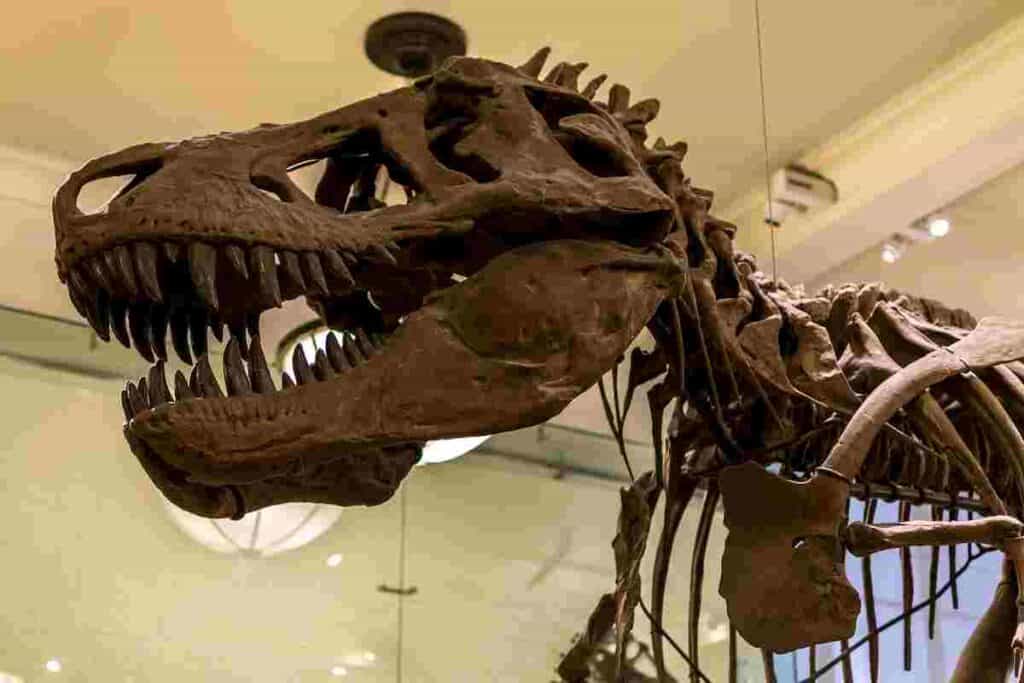The Tyrannosaurus rex has been a popular dinosaur for decades, and it’s easy to see why. It was one of the most famous dinosaurs ever discovered, and its name alone makes people think about prehistoric monsters from another time. But what exactly made this particular species so special that we still remember it today?
There are two main reasons why T. Rex is so famous. First, the public at large is aware of the dinosaur from media and Hollywood actively in the news, movies, documentaries. The public view of the dinosaur is that it captures the imagination, is an apex predator, and its anatomy looks scary and big. The second reason is that from a scientific view, it is one of the most researched dinosaurs, and paleontologists have published research on the 50 plus fossil skeletons discovered.
It is safe to say that ever since Jurassic Park and Jurassic World were released in the early ’90s, a majority of adults and children have watched a movie about dinosaurs, as well as countless documentaries about dinosaurs. Several of them contain segments on the Tyrannosaurus Rex that are one of the show’s major highlights. Even in dinosaur cartoons, we see depictions of the T. Rex. It is no wonder why many recognize the T. Rex when they think of dinosaurs.
The T. Rex represents a carnivorous apex predator in the scientific community, well-known by the past 100 years of published research and the multiple, near-complete skeletons.
Let’s take a deeper look into why T. Rex is so famous in both the public eye and in the scientific world.
[playht_player width=”100%” height=”90px” voice=”en-US-Wavenet-J”]Why Is the T-Rex So Popular?

The T-Rex is a popular dinosaur because of its effective killing nature, as depicted in modern dino-themed movies and animations. You can find numerous movies featuring the Tyrannosaurus rex (T-Rex) and many toys to buy.
Why is there is such trending interest in this dinosaur, and what makes it stand out? Barnum Brown discovered the Tyrannosaurus, or “King Lizard,” in 1902.
Since then, paleontologists have discovered over 50 other T-Rex skeletons. The quality of the fossils has significantly improved over time. (Source)
The T-Rex was a predator, but its diet varied depending on what it could find. In the early years of the T-Rex, it ate sauropods and ceratopsians such as Triceratops or Torosaurus.
Over time, these dinosaurs became rarer. So, T-Rexes adapted to eating smaller prey species like hadrosaurs, ceratosaurs, ornithomimids, and stegosaurs.
Many skeletons have been found in areas where there were water bodies like lakes and rivers. Thus, scientists believe that T-Rexes hunted along river banks.
The T-Rex was intelligent, especially considering its gigantic size. Scientists estimate the average adult had a brain weighing around 400-500 grams, which could process more than 1000 watts of power. Most carnivores have brains comparable to modern reptiles.
Tyrannosaurus rex was arguably smarter than modern-day lions or tigers, and most scientists regard it as an intelligent predator. (Source) https://www.thedailybeast.com/t-rex-was-smarter-than-we-thought
Previously, scientists believed smartness didn’t count much because T-Rexes hunted alone and couldn’t cooperate to build traps for their prey.
YouTube Video – Why Is The T. Rex So ICONIC? (And Why We Love It)
However, some researchers from the University of Arkansas found evidence that suggested T. rexes hunted in packs. The packs seem to have been led by females. They discovered a T-Rex pack that could have died at the same time and place.
Thus, T-Rexes could have lived together, migrated together, and hunted in packs. It’s no wonder they could take down ancient sauropod giants like the gigantic Brachiosaurus. (Source)
Sue the T-Rex is one of the best-preserved skeletons ever found and currently resides at Chicago’s Field Museum. Sue Hendrickson discovered Sue on August 12, 1990, in South Dakota, near the Cheyenne River Sioux Indian Reservation.
Since then, many scientists who have studied the fossil believe that Sue was 20 years old when she died on the banks of a lake. They also determined that Sue was 90% complete by bulk and 73% complete when taking skeletal elements into account. Her good condition allowed scientists to use precise CT scans to reveal numerous new facts about this species. (Source)
One interesting fact about Sue is that her last meal consisted of a mixture of plants such as fruits, nuts, and leaves, all of which she swallowed whole.
❖ Read Now! The Ultimate Guide to Tyrannosaurus Rex
The main article in the series, it is packed with information all about the King of the Dinosaurs. it provides information about the first discovery, some of the latest fossil findings, and covers the anatomy of the dinosaur. Following this, it provides a look at the classification and phylogeny. The places, where T. Rex fossils have been found are described and a few of the key fossil skeletons are described. The master article also covers:
—Interesting facts you may not know about T. Rex
—Unanswered questions about the T. Rex
—Links to the Series Articles (17 in total!) which give deeper info on the dinosaur.
Why is the T-Rex the king of the dinosaurs, and was the T-Rex the biggest meat-eating dinosaur?
- Size
The Tyrannosaurus Rex was one of the largest carnivorous dinosaurs ever found, with some individuals reaching a maximum length of 50-65 feet and an estimated weight of more than seven tons. It had a massive head that could swallow its prey in large bites.
It also had extremely powerful jaws to help it tear chunks off its victims.
- Durability
Fossils show us that T-Rex had strong leg bones. They were fast runners, but their arms weren’t powerful like those of Giganotosaurus and Allosaurus. Additionally, it didn’t adapt the massive sharp claws needed for hunting smaller, faster animals for food.
Ultimately, T-Rexes targeted slow prey, which happened to be gigantic sauropods and other massive herbivores. It’s no wonder they liked snacking on Camptosaurs and Brachiosaurus.
- Strength
Its strong arm and leg muscles would have allowed T-Rex to hold prey in its mouth for a long time. It could easily fend off other carnivores and scavengers looking to steal its meals.
- Speed
Tyrannosaurus Rex was a large dinosaur walking on two powerful legs. Being bipedal allowed it to run faster than the Allosaurus. But it was slower than Giganotosaurus due to its longer lower legs, which meant it had a longer stride and could cover more ground each step.
Thus, T. rexes were faster than some other meat-eaters like the Allosaurus or Troodon but not as fast as Giganotosaurus. The speed of a T-Rex also was slower than smaller, more agile carnivores because of its size and weight.
- Brain
Tyrannosaurus Rex had one of the biggest brains of all dinosaurs, which meant that it was smarter and could hunt better than other predators like the Allosaurus or Troodon. It could think ahead of its prey before making an attack.
The larger the brain sizes, generally, the more areas of learning species can access. Increased memory allowed them to remember where they had buried bones from previous kills, meaning they could stock up food for future consumption. (Source)
What Are the Most Famous T. Rex Fossils?
Here are some facts about three extremely well-known T-Rex fossils:
- Sue
Sue was discovered in South Dakota, in 1990, by a team of professional paleontologists, including:
- Peter Larson
- Phil Currie
- Dan Blakeslee
This fossil remains the most complete T-Rex skeleton ever found, with 90% of her bones’ bulk recovered.
This T-Rex was named after one of the fossil team members, Sue Hendrickson, who discovered it in South Dakota and officially described it.
Sue Hendrickson got immortalized in the movie “Jurassic Park.” The popular movie depicted her as the paleontologist who discovered and named Sue the T-Rex.
In 2005, The Field Museum of Chicago purchased Sue for a record-breaking price of $8 million at an auction.
Sue is on display at the Field Museum of Natural History in Chicago, and she has also been featured in many scientific articles.
- Stan
This fossil was discovered in 1984 by a team led by amateur fossil hunter Kathy Wankel. They excavated Stan near F Lance Creek, Wyoming. Kathy Wankel later named the fossil after her husband, whose nickname was Stan.
Paleontologists discovered this fossil right next to a Triceratops fossil. Scientists believe they died from a massive asteroid impact. Hell Creek Formation is where these fossils were before discovery.
In 2007, Black Hills Institute of Geological Science bought Stan and put him up for auction. Stan became the world’s first-ever dinosaur skeleton to be purchased by a public museum.
“Stan the Man” is on display at the South Dakota School of Mines & Technology in Rapid City, SD.
- Peck’s Rex
Geology student, Suzanne Hays, discovered this fossil in 1983. She named it after her professor from Washburn University, Dr. Robert Peck. He was pivotal in her efforts to excavate the fossil.
Peck’s Rex laid underground in preservation near Faith, South Dakota, and it was a gigantic T. Rex fossil. At 39.4 feet in length, seven meters in height, and four tons in weight, it was one of the biggest Tyrannosaurus Rex fossils yet discovered.
Peck’s Rex is on display at the Museum of Geology at South Dakota School of Mines & Technology, Rapid City, SD. (Source)
Conclusion
To end our article, we can say that the T. rex is famous for its size and intelligence, and its appearance, which captivates people’s imagination. It’s interesting that other similar species, like the Giganotosaurus or the Spinosaurus, are not famous. I guess that’s where movies and media take over and make an impact on the public arena. Nevertheless, because we are continuously adding to the fossil collection every year, I’m sure that there are still some great surprises to come in regards to the great Tyrannosaurus Rex. Now, if we could find that T. Rex egg…

